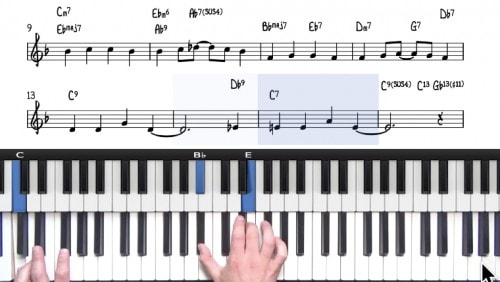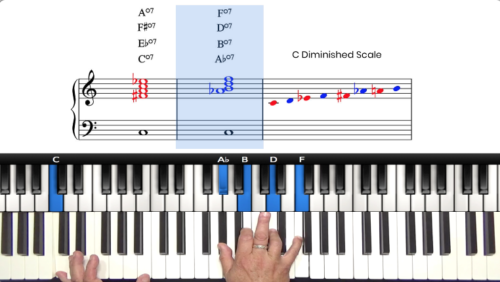Tritone Substitution Tutorial
Tritone Substitution is a reharmonisation technique that can be used to add harmonic interest and variety to a chord progression.
Tritone substitutions are also knows as substitute dominants or sub 5’s so be aware that these 3 terms refer to the same thing.
This lesson will explain what tritone substitution is, why it works and how to apply it to a major 251 progression.
Using the notation, play the Rootless chord voicings in your right hand and the root of the chord in your left hand. Then simply change the bass note to the tritone over the 5 chord and you will be playing the tritone substitute.
What Is A Tritone?
A tritone is an interval of 3 whole steps or 6 half steps on the piano. The tritone marks exactly half of the octave.
Here are a few examples:
-
C to F# is a tritone
-
D to Ab is a tritone
- F to B is a tritone
You will be glad to hear that there are only 6 tritones that you need to learn. This is because tritones are symmetrical when inverted in the sense that you still have a tritone interval.
What Is Tritone Substitution?
Tritone substitution is when a dominant 7 chord is substituted for the dominant 7th chord a tritone away.
You might ask how is this possible?
The answer is because dominant chords that are a tritone apart share the same 3rd and 7th. Remember that the 3rd and 7th are what gives the chord it’s unique harmonic quality so therefore, chords that share the same 3rd and 7th are harmonically very similar.
Let’s look at an example:
The root of G7 is a tritone away from the root of Db7 which makes them tritone substitutes.
Let’s compare the notes of G7 and Db7:
-
G, B, D, F
-
Db, F, Ab, Cb
- Db7 and G7 share the same 3rd and 7th notes but in reverse order.
It’s worth noting here that B (3rd of G7) and Cb (7th of Db7) are enharmonic equivalents, meaning that they are the exact same note but they are spelt or notated differently.
Tritone Substitution and the 251 Progression:
A tritone substitution is an easy way to add variety to a 251 progression. In the key of C, a 251 progression contains the chords:
Dm7, G7 and Cmaj7.
The tritone substitution for the 5 chord G7 would be Db7. G7 and Db7 share the same tritone interval which gives both chords their dominant quality and makes these two chords interchangeable.
All that changes is the bass note but this then has an effect on the extensions and alterations.
Why Do We Use Tritone Substitution?
-
To create very smooth voice leading in a 251 progression, the root of each chord moves down by a half step to resolution rather than moving by 5ths intervals
-
Chromatic, step wise bass line movement
-
To access different scales and arpeggios for improvisation
- Alternative ways to harmonize the melody to add dynamics and interest to your performance
Downloadable Lesson Supplement
Download this PDF containing rootless 251 progressions in all 12 keys:

Lesson Downloads
-
Tritone Substitution Worksheet File Type: pdf
-
Rootless Major 251 Progressions – 12 Keys File Type: pdf
Practice Tips
-
How should you practice tritone substitution?
-
The first step is to use the circle of fifths and play through each of the 12 keys.
-
Play the root in your left hand, and a rootless voicing in your right hand. First play the 251 with root of the V Chord, and then play the same voicings in your right but change the bass note to the b2 or the tritone substitute
-
Next it's time to apply this theory to jazz standards.
-
The first step is to learn the examples covered in the lesson. Then you can work out your own tritone substitutes.
-
Look through the jazz standards you are playing and spot any major 251s.
- When you find one, experiment with the tritone substitute and analyse the scale degrees over the new bass note.








Nice video.
Could you upload tritone Substitution – 12 Keys, pdf ?
Thanks Ioannis, glad you enjoyed the video.
Yes sure we can make a download for that.
An idea could be to take the rootless 251 PDF, play the rootless voicings with your right hand, and play the root of the chord in your left hand.
Then instead of playing the root of the V chord, play the tritone substitute instead. So you left hand will be descending in half steps for each 251.
Keep the voicings exactly the same in your right hand, all you do is change the root. This will give you #5#9 alterations over the tritone substitute.
Hope this helps :-)
Cheers,
Hayden
Thanks for this video and all the rest. I find your method of teaching very intuitive and useful. In fact, every time I think of a question you seem to anticipate that with your next tip! I’m really learning a lot.
Thanks Josh.
I always try to teach from a ‘beginners point of view’ and so it’s great to hear your comments on this :-)
Cheers,
Hayden
Hey. Around 14 minutes in there’s a ii-v-i in cm but you don’t voice the dm using a flat 5. Can you explain? Thanks.
Hi Josh,
Yes whilst the -7b5 chord is most commonly used for the II chord in a minor 251, you will find that both -7 and -7b5 work.
If the b5 is in the melody, then you would be playing a -7b5 chord, but if not, it’s optional whether to play the b5 or the natural 5.
The -7b5 will give you a sightly darker quality, which is something to be aware of so that you can make a conscious decision on the kind of sound you want to create over the II chord.
Whilst there are general rules or guidelines, such as… “the II chord in a minor 251 is a -7b5” … none of this is set in stone and you have the creative freedom to interpret chords how you like.
Hope this helps!
Cheers,
Hayden
Hi Hayden, is it correct, that a tritone substitution can only be interpreted in the light of the basic tone, which would mean, that for rootless voicings there are no real tritone substitutions ? Thanks in advance Felix
Hi Felix 👋
Good question!
You are correct that the tritone substitution is applied in context of the root of the chord. Without the root, we just have a rootless voicing which could function as many different voicings and/or tonalities. In this situation, ‘intent’ is the most important thing.
Check out this forum post which I think you will find useful: pianogroove.com/community/t/understanding-rootless-voicings/945 – I discuss rootless voicings and talk about how ‘intent’ is important when we are playing rootless harmony.
Getting back to your question:
If we have a 251 progression in C Major, and for the V7 chord, we play F-Bb-B-Eb, for me, that sounds like an altered G7 chord with #5 and #9, even though the root is not present.
Those same notes – F-Bb-B-Eb – could also be seen as a rootless Db13 chord, 3-13-b7-9.
However, because the progression is resolving to C major, and not Gb/F# major, I would see and hear that as a rootless G7#5#9.
If you are playing with a bass player, the resultant chord will depend on whether they play a G in the bass, or a Db in the bass.
That’s how I would personally view the situation. I hope that helps Felix and if I can be of further assistance just let me know :-)
Cheers!
Hayden
One thing about the tritone sub is it the 3rd note on. A Dim chord. Eg. the notes of the C Cdiminished. C Eb Gb. When I was 12 my teacher drilled the dim7 arpeggios into my thick head.
Hayden,
Enjoyed the first tritone lesson. But do you always use #5.#9, or other sharp note with the substituted tritone?
Thanks,
Anita D
Hi Anita 👋
Good question!
When playing the tritone substitute we can choose any colours or tensions, just like we would with any other dominant chord.
The key point I was trying to demonstrate is that if we keep the same notes in our right hand that we played for the unaltered dominant 13 voicing, for example a 251 in C Major, for the V chord we could play G13 which is G in the left hand, and F-A-B-E in the right hand (b7-9-3-13)
If we play Db in our left hand, the exact same notes in our right hand create a Db7#5#9 voicing – (3-#5-b7-#9).
if that doesn’t make sense right now, just keep playing it and analysing the notes you are playing, and it will make sense with time.
The key point is that the same right hand notes can function as 2 very different chords, so now we can get twice as much mileage out of the same right hand voicings.
Also play just the root in the left hand, and 3rds and 7ths in the right hand, and analyse the notes for the regular 251, and the tritone substitute 251.
Hope this helps and have fun playing around with this stuff.
Cheers,
Hayden
Hi Hayden, thanks for the tutorial. It is very clear.
I wonder how does chord substitution work in the minor keys?
Also, in chord progressions, can we go to a totally unrelated key? that doesn’t have the same 3rd and 7th?
Hi Dilara,
Good questions here.
Yes indeed tritone substitution works in minor keys in the exact same way. You might like to check out this jazz standard tutorial where we add lots of tritone subs for the minor 251s: pianogroove.com/jazz-piano-lessons/fall-in-love-to-easily-tutorial/ – now that you understand the basic concepts you should have no problems following along with the reharmonisations in that lesson.
For your final question, yes there are other options, such as using the related 2 chord of the tritone substitute. For example, the tritone substitute of G7 is Db7, and so for a 251 in C Major we can also play Ab-7 to Db7 to Cmaj7.
This is a more advanced application and Tuomo explains this in his course on Advanced Improvisation Principles here: pianogroove.com/jazz-piano-lessons/advanced-improvisation-course/
I hope that helps, check out the lessons above and let me know if you have any further questions.
Cheers,
Hayden